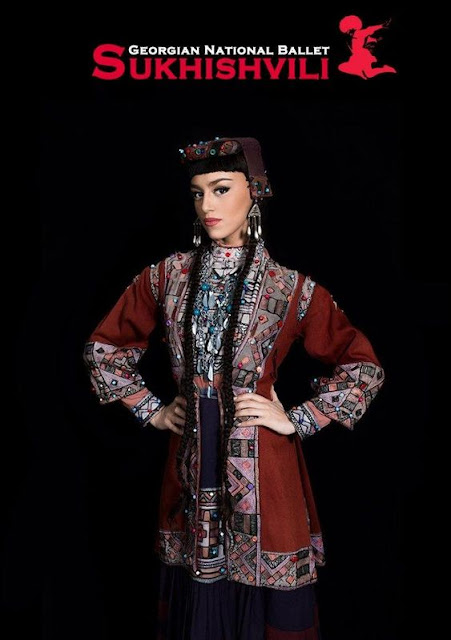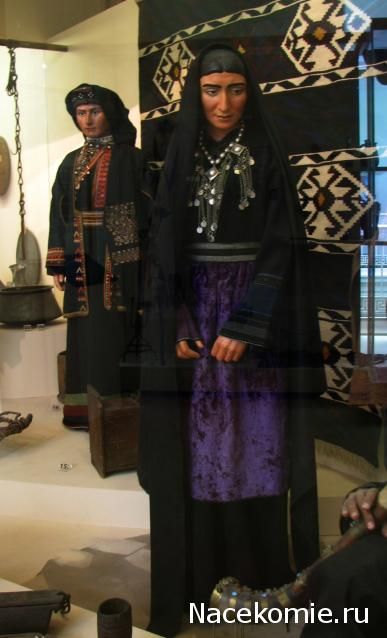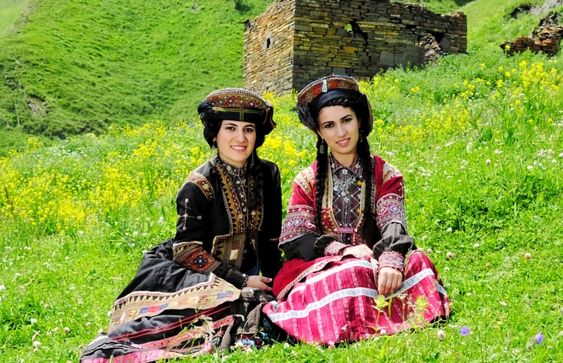Hello all,
Today I would like to talk about the folk costume and embroidery of a relatively unknown ethnic group, that of the Khevsur of the nation of Sakartvelo,საქართველო, which in English is usually referred to as 'Georgia'. This term is derived from the ancient Persian word for these people, which was 'Gurgan'. They call themselves the Kartli. The current state is very ethically diverse. Here are two maps of the ethnic composition of this nation, the first showing the physical geography, and the second the political divisions.
The main non-Kartvelian groups include the Abkhaz in the northwest, the Ossetians in the north central area, the Armenians in the northwest and south central area, the Azeris to the east of the Armenians, and smaller groups of Chechens [Kists], Greeks, Avars, Yezidi, and others. You will also notice that a great deal of the country is sufficiently elevated as to be uninhabitable.
The Kartvelian people themselves speak 4 languages that make up a separate language family. Svan, Mingrelian, Laz, and Kartvelian proper.
The Kartvelians are usually depicted using a form of dress which was originally that of the aristocracy and urban dwellers.
There were originally many unique costumes worn by the country people, but most of these are now little known, and information about them is difficult to obtain, at least if one does not read Kartvelian. Here is a drawing of some of them. The Khevsur are the second couple from the left, including the boy, and the second woman who is facing backwards.
The Khevsur are a branch of the Kartvelian people who have maintained much of their distinctive local culture. They live in the northeast of the country, in an area usually called Khevsureti ხევსურეთი, 'The land of valleys'.
A glance at the image af the head of the article will immediately inform you that the attire of both men and women is highly ornamented, mostly with embroidery and applique.

The main garments of the men's costume is a long tunic and pants. Most of the garments in this region are made of black or indigo cloth. The tunic falls almost to the knees, and is slit up the sides to the waist. It is worn outside the pants. Here is Max Tilke's drawing of the shirt and pants.
Here is another drawing by Nino Brailashvili. I have to wonder if they both drew the same museum piece.
These garments are relatively simple compared to many others. Note that the opening of the shirt is on the right side, showing influence from Persia, and not on the left as the Russians wear it. Here are a couple more examples from a museum in Russia.
Note the appliqued triangles around the side slits and cuffs. The embroidery is mostly cross stitich, with braid stitch and ribbon applique. Diagonal and zigzag motifs must be embroidered on a separate piece of cloth and then appliqued. Here are a couple more images showing the shirt embroidery.
Some more images of what appear to be newer shirts, with coarser embroidery, simpler composition and brighter colors. A few more older shirts for contrast.
The back of the shirts are often ornamented with a zigzag motif.
You can see that they often wear the standard Georgian belt with the ubiquitous dagger. The main motifs in the embroidery are the rhomb and the cross, done mostly in warm colors. Here is an old photograph which was colorized, but whoever did it did not know what to do with the embroidery. You will also notice that often, instead of the pants being embroidered, they are left plain, and embroidered leggings are worn over them. In this image you can see leather moccasins worn over the woolen socks. Often the socks themselves were knitted with bright designs. Note that the motifs are the same as those used on the shirts and leggings, and that beads and pearl buttons are also used as ornament. A jacket called chokha may be worn over the tunic. Women wear a similar jacket, and some of these may be women's.
If you look at the various photos, you will see that embroidered pillbox hats, sheepskin hats with long fleece, black or white, or cloth wraps were worn on the head.
Dagger, sword, and small shield, [target or targe] complete the ensemble. A man was not considered to be fully dressed unless he was armed.

Until quite recently, to the beginning of the 20th century, chain mail was part of a man's ensemble when appropriate.
The womens' costume is similarly simple in cut and elaborate in ornament. Here is another drawing by Nino Brailashvili. A few rows of colored cloth are sewn to the bottom hem to lengthen the dress. These are gathered in the back for extra fullness.
As you can see, there is a jacket similar to that which the men wear. Elaborate stockings are also worn, often with no shoes. Also a crown shaped headdress is worn, often with a cloth wrapped around the head in various ways. Take another look at the image at the head of the article. A couple more drawings by Nino Brailashvili, including one showing a woman churning butter. Nino' drawings of how to wrap the headdress for a married woman, followed by an illustration of a woman in mourning.
And a Khevsurian cradle.
Some various images showing details of the womens' outfits.
Note that this woman is wearing an apron, and the dress has rather different ornamentation. Such an apron is visible in only a handful of the images which I have found.
Here are a number of closeups of Khevsur embroidery. Some of these are from boutique items sold as souvenirs.
Just a few more images of this costume.
This man is wearing an embroidered cap and a modern style vest with traditional Khevsur embroidery.
This traditional attire would NEVER have been worn with loose hair like this. It would have been scandalous.
Here is the Georgian State Dance Ensemble, Sukhishvili, doing a dance from this region, Khevsuruli. The stage costumes do not have as much embroidery, you will notice, and include an apron, which only appears in a couple of the images which I have given above.
Another group doing Khevsuruli. These costumes have been modified for the stage. The mens' shirts are too short, the front ornamentation has been rounded off, and the motifs made very large. but great dancing.
Thank you for reading. I hope that you have found this to be interesting and informative. I also hope that some of you have been inspired to create something from this ornamental tradition so as to include a bit of the spirit of Khevsureti in your life.
Roman K.
email: rkozakand@aol.com
Source Material:
Nino Brailashvili, 'Georgia as I saw it' Tbilisi,1990
Max Tilke, 'Costume Patterns and Designs', New York, 1990
Tatyana Razina et al, 'Folk Art in the Soviet Union', New York, 1990

















.jpg)

















.jpg)

























.jpg)





.jpg)













.jpg)






























































.jpg)

.jpg)






























































